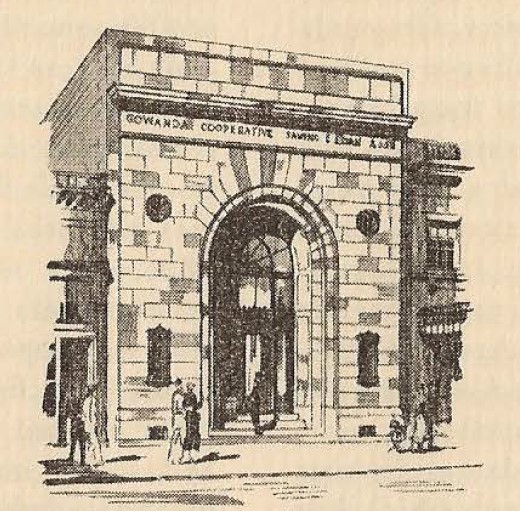|
important civic improvements. The Hollywood Theatre was built by Richard Wilhelm and opened on April 19, 1926. As the village grew and the population increased it was necessary to build additions from time to time to the Gowanda High School. The last improvements were made in 1936 at a cost of $75,000. Under the supervision of Professor Harold G. Hoffman, 1020 pupils are given all the advantages of modern education. The new library opened in September, 1936. The post office building was completed in Septem• her, 193 7, and the new Municipal Hall opened in November of the same year. Concluding a history, such as this Gowanda chronology has turned out to be, can be as |
difficult as starting it. Yet that is hardly the case with this book. For assuredly here in Gowanda, fate, fortune and fortitude have built every essential foundation for individual and community prosperity. It is a pleasant thought that this can be the concluding page, then, with all factors singularly well established for sustained progress in the years to come. Gowanda still is ''the beautiful valley between the hills." The splendid way in which it has fulfilled its destinies to date is the surest of all ssurances that the sturdy heritages fr9m the past will continue to safeguard those destinies in he uture-come what will! |
|
Page Sixty |
|
A RECORD OF PARALLEL GROWTH |
|
 |
|
|
FOR more than five decades, the Gowanda community has had a helpfully stabilizing influence in the Gowanda Co-operative Saving and Loan Association. The formation of the Association was accomplished at a time when financial conditions were anything but stable. In fact, it was the chaotic and unprincipled practices so prevalent with the private bankers of that period which lead to the organization of the Association on September 21, 1889. |
A meeting took place that evening in the Lincoln & Wilber law offices in response to the expressecl desires of many of the leading citizens for a trustworthy saving and loan association in Gowanda. Those present were J. S. Torrance, A. C. Stafford, George J. Lincoln, Albert Gaensslen, F.J. Herdeg, John Romer, J oho A. Falk, William H. Bard, George H. Swift, George Schlotzer, J. E. Van Deusen, John G. Mentley, John Shepflin and Fred J. Blackmon. |
|
Page Sixty-one |
|
|
The significance of that meeting has been of far reaching and long sustained importance. As recently as the last depression, Gowanda has shown a commendable resilience to ''bad times" largely because it has so long been a community where home ownership is the rule rather than the exception. And a very large number of those who have attained home ownership in Gowanda have been shareholders and loan grantees of the Gowanda Co-operative Saving and Loan Association. The consistent growth of the Association — a record in which no shareholder — has ever suffered a loss had its foundation in that prudent and careful management which has been the watchword since that very first meeting. The original founders would have indeed been amazed if they could have foreseen that the Association they were forming would grow in the next fifty years to a total of 7,322 share-· holders with resources of practically $5,000,000.00. It is interesting to note from the first minute book that the total cost of incorporation was $12.33. The first mortgage was granted to George Schlotzer for $375. The Association moved to the law office of J. S. Torrance in |
January, 1891, at a rental of $35 per year. It was then decided to pay the secretary a salary of $50 annually or 98 cents a week. As early as 1892, F.J. Herdeg was appointed secretary-manager of the Association and remained as the directing head of the institution until his death in 1934. Mrs. F. J. Herdeg was made the assistant secretary in February, 1893-at a salary of $26 per annum-and later became secretary. Fred J. Blackmon, who was appointed the Association Attorney at the very first meeting, continued in that capacity until his death in 1930. The careful and sound management of the Association was again reflected on page 14 7 of the Minute Book which carries a resolutio11 that made all mortgages payable in gold. And the Association was early interested in civic as well as personal progress for page 165 records a loan of $875 to the M. T. Hill Hose Company on August 18, 1894 for the purpose of erecting their building. The definite progress being made by the Association was manifested in resources of $80,000 at the end of 1895. Larger quarters were imperative and the office was moved into the Bank of Gowanda Building-now the |
|
Page Sixty-two |
|